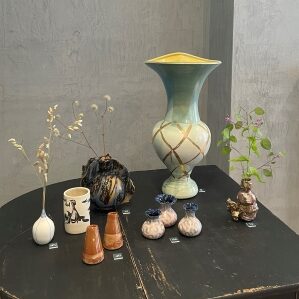Spinning a Yarn
By Akshita Pyla
Spun; a past tense verb that has several meanings including swirling and turning. But how many of us ever wondered if it also meant something woven, crocheted and lacy? Is it not interesting to discover that the beautiful knitted clothes we know and wear today have a significant, ancient history? Knitted artefacts in Egypt can be dated back to the 5th century AD. However, it was believed to have originated from the Middle East and then travelled to Egypt eventually. Later in the 14th century, knitted fabric was used by fishermen to protect themselves from harsh climates in the sea. Then, gradually in the 18th-century knitting expanded into a local industry in Scotland and Highlands. Today, in the 20th-century Knitwear is seen as mainstream fashion apparel. It has evolved into modern, gender-neutral fashion clothing portrayed by many high-end fashion brands globally. Hence, the transition has been tremendously drastic. But how can we not talk about the purled miracle fabric, wool that has been pre-dominantly existent for several millenniums when the theme for this month is all about Spun? Find out more here in Spinning a Yarn. Illustration Ellie Darby- Pragnell
One of the most interesting things about knitwear may well be that it has developed into clear patterns and textures to not just be an item for warmth but also to use it for its designs, clever patterns and texture and today for its fashion credibility.
Many of us, as we pull on a jumper in the middle of winter may not be aware of the Fairilse or cable knit patterned fabric we are donning. But in reality, there are actually so many interesting names and their derivations. So, here is a little list to break them down for you.

LA Fetiche, Josef Fair-Isle wool sweater Available at Matchesfashion.com
Let us begin with Fairisle….this authentic hand knitting pattern’s origin is not very certain. However, it is believed to be born in the northern part of Scotland. Basic Fairisle fabric is knitted with two or more colours, one colour is used to make the knit while the other is held in its place. This intrinsic pattern has been continuously practised for several generations and has majorly evolved.

Paco Rabanne, Embellished cable knit wool sweater Available at Brownsfashion.com
Moving on to the next, the Cable, this spiral design is just about 100 years old. Born somewhere between a tiny group of islands in the Atlantic Ocean it was initially modelled for fishermen. It was locally called the ‘Thicker local wool’.

JW Anderson, textured intarsia-knit cardigan Available at Mytheresa.com
Another one is, Intarsia, different colours and patterns are interlinked to create the design. Also known as ‘inlaid by hand’ technique. It derives its heritage from the Scottish lands. This design is dealt with precision and its time consuming.

LA Fetiche, Marianne chunky Aran-knit wool sweater Available at Matchesfashion.com
Let us continue with, Aran, originated from Aran island in Connemara near the west coast of Ireland. This design was invented by women belonging to the fisherman families. They were originally knitted in Sheep wool’s natural colour. Sweaters were waterproof and perfect for Irish weather.

ALANUI, Positive Vibes fringed crocheted cotton cardigan Available at Net-a-porter.com
This next knit design, Crochet is predicted to have evolved from China and later was adapted by India, Persia and Turkey. The design travelled to Europe in the 1700s. In this technique, the thread work is done over stretched a background.

Miu Miu, striped boucle top Available at Brownsfashion.com
Another interesting design, Boucle, this fabric style was popularized in the 1940s in the United States when famous Architect Florence knoll requested designer Eero Saarinen to create her a womb chair. This piece is usually made from curled fibres and today it is also known as Knoll’s Classic Boucle. About 20 years later Chanel begin experimenting and eventually gave birth to the new Boucle jacket in the late1950s.

Marni, Argyle mohair-blend vest Available at Net-a-porter.com
The last and probably a well-known design, Argyle, originates from Tartan of Clan Campbell in the Western part of Scotland in the 17th Century. The design is seen in the form of diamonds or lozenges. The fabric is knit by overlapping them diagonally. This woven fabric is also being used in the contemporary fashion world.

Ganni, Argyle merino wool and cashmere-blend sweater Available at Net-a-porter.com
This ancient, beautifully crafted art has thus passed on from several generations. But, today as we began mass-producing, we may have lost ways of protecting and utilising nature in the best way possible.
However, as we turn into a much greener world, some brands are picking up the mantel of sustainability and giving back to nature the right way.
A London based company, Sheep Inc. has taken initiative to create Carbon negative Jumpers. These jumpers have a feature tag that allows customers to get regular updates on the well-being of sheep on the farm. A unique approach that allows transparency of their system.

Image Sheep Inc
Parallelly, British design and manufacturing company, Turtle Dove has announced that they will provide shelter for every 100% cashmere donated throughout this month of February. Customers donating will receive free pair of Cashmere gloves and some discount on their next purchases.

Image Turtle Doves
So that next time you reach for some wooley comfort you can know a little bit more about what you are wearing. These magnificent patterns that our ancestors have passed on to us that we wear around so casually thus have been revealed to have such glorious history.
If you enjoyed reading Spinning a Yarn, then why not read Art and the Body Here.
.Cent magazine London Be Inspired; Get Involved





